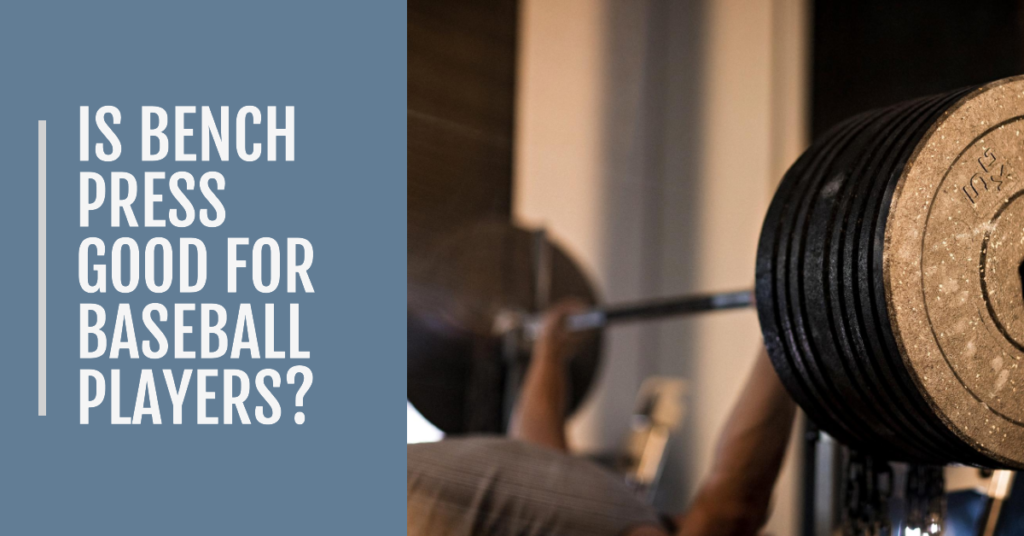Baseball players should bench press for optimal performance and strength gains. Many benefits, such as improved power, bat speed, throwing velocity, and injury prevention, make bench pressing an essential exercise for baseball players.
Additionally, it helps develop upper body strength, stability, and core muscles, contributing to overall athletic performance on the field. Bench pressing engages significant muscle groups, including the chest, shoulders, triceps, and even the muscles in the back and core. It aids in generating explosive power necessary for batting, throwing, and fielding plays.
Incorporating bench press exercises into a baseball player’s training routine can significantly improve their game performance and overall fitness.
Benefits Of Bench Press For Baseball Players
The bench press can significantly benefit baseball players by improving upper body strength, power, and throwing velocity. This exercise helps generate the explosive force required for batting and pitching, enhancing overall performance on the field.
A solid strength training routine can significantly benefit baseball players, and one exercise that shouldn’t be overlooked is the bench press. This compound movement primarily targets the chest, shoulders, and triceps, but it offers a range of benefits that can enhance a baseball player’s performance on the field.
Let’s delve into some of the critical advantages of incorporating the bench press into a baseball player’s training regimen:
Increased Upper Body Strength:
- Develops strong chest muscles: The bench press is a fantastic exercise for targeting the pectoralis major muscle, which forms the bulk of the chest. Strengthening these muscles can improve stability and endurance during baseball-related movements, such as making accurate throws or swinging a bat.
- Builds robust shoulder muscles: The pressing motion of the bench press also engages the deltoid muscles in the shoulders, helping to improve overall upper body strength. This can be particularly beneficial for baseball players in generating power and stability during throwing and hitting.
Improved Power And Explosiveness:
- Enhances muscular power: The bench press is a compound movement that engages multiple muscle groups simultaneously, including the chest, shoulders, triceps, and even the core. Incorporating this exercise into a baseball player’s training routine can increase overall power and explosiveness, allowing them to generate more force during batting, throwing, and fielding.
- Enhances ballistic movements: Baseball requires quick and explosive movements, and the bench press can help develop the fast-twitch muscle fibers necessary for these actions. Baseball players can improve their ability to generate rapid force and execute explosive movements efficiently by training with the bench press.
Enhanced Throwing And Hitting Abilities:
- Increased throwing velocity: The bench press strengthens the muscles involved in the throwing motion and improves overall upper body power, expanding the throwing rate. A more muscular chest, shoulders, and triceps allow for more significant force generation during the throwing action, resulting in faster and more accurate throws on the field.
- Improved hitting power: A powerful swing is crucial for baseball players, and the bench press can improve hitting abilities. A muscular chest and shoulder muscles are vital for generating bat speed and transferring energy from the body to the swing, resulting in more powerful and effective hits.
Incorporating the bench press into a baseball player’s strength training routine can significantly improve upper body strength, power, and overall performance on the field. However, it’s essential to note that proper technique and gradual progression should always be prioritized to avoid injury and maximize the benefits of this exercise.
Impact Of Bench Press On Performance
Bench pressing can positively impact baseball player performance, assisting with increased upper body strength, power, and swing speed. Incorporating bench press exercises into training routines can benefit players by enhancing their overall athletic abilities on the field.
Muscular Endurance And Stamina Gains:
- Baseball players can benefit from incorporating bench press exercises into their training routine as they help improve muscular endurance and stamina.
- Bench pressing engages multiple muscle groups, including the chest, shoulders, and triceps, essential for baseball’s throwing, catching, and swinging movements.
- By performing bench presses regularly, players can develop the strength and endurance necessary to maintain optimal performance throughout the game.
- Increased muscular endurance allows players to consistently exert force during long and demanding games, preventing early fatigue.
- Performing high repetitions with lower weights during bench press sessions enhances muscular endurance, enabling players to perform multiple repetitions of throwing and hitting actions without compromising their form or power.
Reduction In The Risk Of Injuries:
- Engaging in bench press exercises can contribute to a reduced risk of injuries among baseball players.
- Strengthening the muscles involved in throwing and hitting actions, such as the pectorals, deltoids, and triceps, can improve joint stability and support proper movement mechanics.
- Bench press exercises also help in building a solid upper body, which aids in absorbing and dissipating impact forces effectively, thereby minimizing the risk of injuries.
- Strengthening the chest and shoulder muscles can stabilize the joint, reducing the likelihood of shoulder problems common in baseball players.
- Proper technique and gradual progression in bench press training should be followed to prevent overuse injuries and ensure the safety of players.
Increased Speed And Agility:
- Including bench press exercises in a baseball player’s strength training routine can improve speed and agility.
- Developing strength in the chest, shoulders, and triceps through bench press helps generate power and explosive force needed during quick movements on the field.
- The increased upper body strength achieved through bench pressing can contribute to faster arm swing actions during throwing and hitting, enabling players to generate more bat speed and throw with incredible velocity.
- Besides enhancing strength, bench press exercises also improve stability and core strength, contributing to better balance and agility on the field.
- Improved speed, agility, and power can give baseball players a competitive edge, allowing them to react quickly and efficiently during fast-paced game situations.
Remember, incorporating bench press exercises into a baseball player’s training regimen can positively affect their performance. It can enhance muscular endurance, reduce the risk of injuries, and increase speed and agility on the field. It is essential to ensure proper technique, gradual progression, and tailored training programs, considering individual needs and goals.
Stay tuned for more insightful discussions on baseball training strategies!
Proper Form And Technique
Baseball players should carefully consider their form and technique when deciding whether to incorporate bench press exercises into their training routine.
Should Baseball Players Bench Press:
Bench pressing is a popular exercise for developing upper body strength, but is it suitable for baseball players? This section will explore the importance of proper form and technique when performing the bench press.
Grip, Hand Placement, And Body Positioning
Baseball players should pay close attention to their grip, hand placement, and body positioning to maximize the benefits of the bench press and avoid potential injuries. Here’s what you need to know:
- Grip:
- Use a comfortably wide grip, allowing for optimal stability and control.
- Avoid gripping the bar too tightly, as it may hinder your performance and strain your wrists.
- Ensure your thumbs are wrapped around the bar to maintain a secure grip.
- Hand Placement:
- Position your hands slightly wider than shoulder-width apart on the bar.
- Find a grip width that feels natural and adequately aligns your wrists and elbows.
- Distribute the weight evenly across your hands to prevent excessive strain on any particular muscle group.
- Body Positioning:
- Lie flat on the bench with your feet planted firmly on the ground.
- Ensure your back, shoulders, and glutes are in contact with the bench throughout the movement.
- Maintain a slight arch in your lower back to promote stability and optimal muscle engagement.
Breathing Techniques And Tempo
Proper breathing techniques and tempo are crucial when performing the bench press. Consider the following points:
- Breathing Techniques:
- Take a deep breath before initiating the lift, filling your lungs with air.
- Hold your breath during the movement’s eccentric (lowering) phase to improve stability and support your core.
- Exhale forcefully as you push the weight away from your chest, maintaining tension in your core muscles.
- Tempo:
- Control the bar’s descent in a slow and controlled manner to fully engage your muscles.
- Explode upwards during the concentric (lifting) phase, using the force generated by your chest, shoulders, and triceps.
- Avoid bouncing the bar off your chest or using excessive momentum, as it can compromise both form and safety.
Crucial Safety Considerations
While the bench press can be a practical exercise, it’s essential to prioritize safety when incorporating it into your training routine. Be mindful of the following safety considerations:
- Warm up adequately before attempting heavy bench press sets to prepare your muscles, joints, and connective tissues.
- Start with lighter weights and gradually progress to heavier loads to ensure your muscles can handle the stress.
- Use a spotter when lifting heavy weights if you cannot complete a repetition safely.
- Avoid hyperextending your lower back or allowing the bar to drift too far up or down, as it can lead to strain or injury.
- Listen to your body; if you experience pain or discomfort, adjust your technique or seek professional guidance to prevent further issues.
Baseball players can safely incorporate the bench press into their training regimen by maintaining proper form and technique. Remember to focus on grip, hand placement, body positioning, breathing techniques, tempo, and crucial safety considerations. Incorporating these elements into your bench press routine can help boost your upper body strength without compromising your performance on the baseball field.
Frequency, Sets, And Repetitions
Baseball players often debate whether they should include bench pressing in their training regimen. Understanding the optimal frequency, sets, and repetitions for bench press exercises can help players make an informed decision. Players can determine if bench pressing aligns with their overall training approach by considering their specific goals and performance demands.
Should Baseball Players Bench Press:
Finding The Right Balance For Individual Players:
- Every baseball player has unique strength and conditioning needs, so finding the right training balance is crucial. When it comes to bench pressing, considering the individual’s current fitness level, goals, and position on the team becomes paramount. Here are some key factors to consider:
- Determine the player’s current strength: Assess the player’s bench press capability to establish a baseline before designing a training program.
- Establish realistic goals: Set specific and attainable strength goals that align with the player’s position on the team and overall performance objectives.
- Consider position-specific demands: Different positions require varying degrees of upper body strength, so tailor the bench press routine accordingly.
- Balance with other exercises: Bench pressing should be just one component of a well-rounded strength and conditioning program. Incorporate other exercises that target different muscle groups to prevent imbalances and enhance overall performance.
Progressive Overload And Periodization:
- Progressive overload and periodization are critical principles in any strength training program, including bench pressing. By gradually increasing the intensity and volume of the workouts, athletes can maximize their strength gains. Here’s how to incorporate these principles effectively:
- Start with a solid foundation: Begin with a weight that allows for proper form and technique. Focus on mastering the movement before progressing further.
- Gradually increase weight: Once proper form is achieved, gradually increase the weight by small increments, ensuring the player can complete the desired number of repetitions with the added load.
- Vary sets and repetitions: Implement different locations and repetition schemes to target other strength and muscle endurance aspects. For instance:
- Low reps and heavy weights (2-6 reps) for maximum strength gains.
- Moderate reps and consequences (8-12 reps) for hypertrophy and muscle growth.
- Higher reps and lighter weights (15-20 reps) for muscular endurance.
- Periodize training phases: Incorporate periods of higher intensity, lower volume training, and vice versa, to prevent overtraining and plateaus. This cycling approach optimizes performance improvements.
Rest And Recovery Intervals:
- Rest and recovery are as crucial as bench pressing and gaining strength training. Adequate rest allows the muscles to repair and grow, preventing injuries and optimizing performance. Consider the following guidelines:
- Allow for proper rest between sets: Depending on the intensity and rep range, 2-5 minutes between sets ensure full recovery before the next scene.
- Plan recovery days: Incorporate scheduled rest days or lighter training sessions to allow the body to recover and adapt to the training stress.
- Prioritize sleep and nutrition: Quality sleep and a well-balanced diet are vital for muscle recovery and growth. Aim for 7-9 hours of uninterrupted sleep and provide the body with adequate nutrients to support training demands.
- Listen to the body: Pay attention to any signs of fatigue, excessive soreness, or decreased performance. Adjust training volume and intensity accordingly to avoid overtraining.
- Cross-training and active recovery: Other activities like swimming or yoga can complement bench-pressing workouts and promote functional healing.
Finding the right frequency, sets, and repetitions for bench pressing is an individualized process. Consulting with a qualified strength and conditioning coach or sports performance professional can help tailor a program that suits specific needs and maximizes performance gains.
Supplementary Exercises To Enhance Bench Press Performance
Baseball players may benefit from supplementary exercises to improve their bench press performance. Implementing these exercises can help enhance upper body strength, power, and overall performance on the field.
When it comes to improving bench press performance, baseball players can benefit from incorporating supplementary exercises into their training routine. These exercises target muscles for a solid and robust bench press, aiding overall strength and performance. Below, we will explore two practical supplementary practices: Dumbbell flies, incline bench presses, push-ups and chest dips, tricep extensions, and shoulder exercises.
Dumbbell Flyes And Incline Bench Press:
- Dumbbell flyes: O The dumbbell flyes exercise targets the pectoral muscles, helping to enhance chest strength and stability.
😮 Start by lying on a flat bench with a dumbbell in each hand, palms facing inward.
😮 Slowly lower the dumbbells to the sides, maintaining a slight bend in the elbows.
😮 As you bring the dumbbells back up, focus on contracting the chest muscles.
😮 Perform this exercise controlled, avoiding excessive swinging or jerking movements.
- Incline bench press: O Incline bench press is beneficial for strengthening the upper chest muscles, which are crucial for a powerful bench press.
😮 Set the bench at a 30-45 degree incline, ensuring stability throughout the exercise.
😮 Grip the barbell with hands slightly wider than shoulder-width apart and unrack it.
😮 Slowly lower the bar towards the upper chest, maintaining control and a stable body position.
😮 Exhale and push the barbell back up to the starting position, focusing on using the chest muscles to perform the movement.
Push-Ups And Chest Dips:
- Push-ups: O Push-ups are a classic exercise that targets the chest muscles, triceps, and shoulders, all involved in bench press performance.
😮 Start in a plank position, with hands slightly wider than shoulder-width apart and feet together.
😮 Lower your body by bending the elbows until your chest is just above the ground.
😮 Push through the palms of your hands to extend your arms and return to the starting position.
😮 Remember to engage your core and maintain a straight body line throughout the movement.
- Chest dips: O Chest dips primarily work the chest muscles, triceps, and shoulders, aiding in bench press strength and stability.
😮 Use parallel bars or dip bars, positioning your hands shoulder-width apart.
😮 Lower your body by bending the elbows until your upper arms parallel the ground.
😮 Push through your palms to extend your arms and return to the starting position.
😮 Focus on keeping your chest up and shoulders pulled back throughout the exercise.
Tricep Extensions And Shoulder Exercises:
- Tricep extensions: The strong triceps are essential for a powerful bench press, as they assist in locking out the weight at the top of the movement.
😮 Use dumbbells or an EZ bar for tricep extensions.
😮 Start with the weight held overhead, arms fully extended.
😮 Lower the weight behind your head by bending your elbows, keeping your upper arms stationary.
😮 Extend your arms back to the starting position, focusing on contracting the triceps.
- Shoulder exercises: O Strong shoulders provide stability during the bench press and contribute to overall pressing power.
😮 Include overhead presses, lateral raises, and front raises in your shoulder workout routine.
😮 Varying the angles and weights used in these exercises can target different parts of the shoulder muscles, aiding in overall shoulder strength and stability.
By incorporating these supplementary exercises into their training routine, baseball players can enhance their bench press performance, build upper body strength, and improve overall power and stability. Remember to gradually increase the weights and maintain proper form to ensure safety and effectiveness in these exercises.
Myths And Misunderstandings
Baseball players often wonder if bench pressing is necessary for their performance, but many myths and misunderstandings surround this topic. Let’s explore the truth and benefits of bar pressing in baseball training.
Will Bench Press Make Baseball Players Slower?
One common myth surrounding baseball players and bench pressing is the assumption that it will make them slower on the field. However, this notion is not entirely accurate. Let’s explore the truth behind this myth:
- Muscle mass and speed: Bench pressing can increase muscle mass but doesn’t necessarily hinder speed. Building upper body strength through bench pushing can improve explosive power, which is crucial for baseball players when sprinting, throwing, or swinging.
- Proper training: It’s important to note that incorporating bench press exercises into a baseball player’s training regimen should be done with proper technique and consideration. Focusing on functional movements, explosive power, and overall athleticism is critical to maximizing speed and agility.
- Balanced training: While developing upper body strength is essential, baseball players should also prioritize training other muscle groups, especially the lower body and core. A well-rounded strength and conditioning program with various exercises and movements can enhance athletic performance.
Does Bench Press Negatively Impact Flexibility?
Another misconception regarding bench pressing and baseball players is that it negatively impacts flexibility. Let’s separate fact from fiction:
- Proper form and range of motion: When performed with correct form and full range of motion, bench pressing can help maintain or improve flexibility. The exercise engages the shoulder and chest muscles, promoting joint stability and mobility.
- Stretching and mobility work: Baseball should incorporate stretching and mobility exercises into their training routine to counterbalance any potential tightness resulting from bench pressing. This will help maintain overall flexibility and prevent any adverse effects on the range of motion.
- Balanced training: Just as with speed, baseball players need a well-rounded approach to training. Incorporating exercises that target all muscle groups, including those typically neglected in a bench press-focused routine, will help maintain a balanced level of flexibility throughout the body.
Remember, proper training, technique, and overall balance are the keys to avoiding any potential negative impacts on flexibility when it comes to bench pressing.
Are There Risks Of Overdeveloping Certain Muscle Groups?
Lastly, addressing overdeveloping certain muscle groups, such as the chest and arms, is essential when bench pressing. Here’s what you need to know:
- Balanced muscle development: While bench pressing primarily targets the chest, shoulders, and triceps, the risk of overdeveloping these muscle groups can be minimized by incorporating a well-rounded strength and conditioning program. This includes exercises that target the back, lower body, and core muscles.
- Posture and injury prevention: Overdevelopment of certain muscle groups without proper attention to opposing muscles can lead to muscular imbalances, which may affect posture and increase the risk of injury. Baseball players must maintain overall muscular balance and focus on exercises that promote proper alignment and joint stability.
- Individual needs: Each baseball player has unique strengths and weaknesses. Working with a qualified strength and conditioning coach or trainer can help customize a training program that addresses specific areas of concern and ensures balanced muscle development.
Bench pressing can be valuable to a baseball player’s training routine when executed correctly and with a well-rounded strength and conditioning program. It can enhance speed, power, and overall performance on the field without negatively impacting flexibility or risking the overdevelopment of specific muscle groups.
Addressing Concerns
Baseball players’ bench press is a topic of concern, yet its benefits are debatable. Some argue it enhances power and upper body strength, while others believe it may hinder flexibility and cause strain injuries. Ultimately, the decision should be based on individual needs and goals.
Many baseball players question whether incorporating bench press exercises into their training routine is beneficial. In this section, we will address common concerns and provide insights on how to effectively balance bench press with other training components, incorporate mobility and flexibility exercises, and customize training plans based on position and individual needs.
Balancing Bench Press With Other Training Components:
- Resistance training is essential for baseball players as it helps build the strength, power, and endurance required.
- While bench press is a popular exercise for strengthening the chest, shoulders, and triceps, it should not be the sole focus of a training program.
- To ensure well-rounded development, it is crucial to incorporate other exercises such as squats, deadlifts, rows, and shoulder presses.
- Varying the exercises helps target different muscle groups, reducing the risk of imbalances and overuse injuries.
Incorporating Mobility And Flexibility Exercises:
- Baseball players rely on their agility and range of motion to perform at their best.
- In addition to strength training, it is crucial to include mobility and flexibility exercises in the training routine.
- Dynamic warm-up exercises, such as lunges, hip rotations, and arm circles, help improve joint mobility and prepare the body for the workout.
- Stretching exercises, such as hamstring, chest, and shoulder rotations, enhance flexibility and reduce the risk of muscle strains or tears.
Customizing Training Plans Based On Position And Individual Needs:
- Different positions in baseball have specific physical demands and requirements.
- Pitchers, for example, require a solid and stable core, shoulder mobility, and leg strength.
- Position players, on the other hand, may benefit from upper body strength, speed, and agility.
- Creating training plans that consider these position-specific needs and individual strengths and weaknesses is essential.
- Consulting a qualified strength and conditioning coach can help athletes tailor their training programs accordingly.
By addressing concerns regarding bench press exercises in baseball training, we can see how they can be effectively balanced with other training components, incorporate mobility and flexibility exercises, and be customized based on individual needs and positions. As such, baseball players can reap the benefits of a well-rounded and personalized training program to excel on the field.
Frequently Asked Questions Of Should Baseball Players Bench Press
Should Athletes Bench Press?
Yes, athletes should bench press athletes their upper body muscles and improve overall performance.
Does Bench Press Help Bat Speed?
The bench press can improve bat speed by strengthening the relevant muscles used in swinging.
What Do Baseball Players Bench?
Baseball players typically bench press weights to strengthen their upper body and improve their power.
Does Bench Press Translate To Baseball?
B bench presses can translate to baseball by improving strength and power.
Conclusion
To sum up, bench pressing can offer numerous benefits for baseball players. It strengthens the muscles necessary for throwing, hitting, and fielding, helping players improve their overall performance on the field. Additionally, it can contribute to enhanced power, speed, and endurance, giving players a competitive edge.
However, it is essential to approach bench pressing with caution and under the guidance of a qualified trainer or coach. Improper technique or excessive weight can lead to injuries, hindering a player’s progress. Moreover, bench pressing should be supplemented with other exercises that target specific baseball-related movements and muscle groups.
By incorporating a well-rounded strength training program that includes bench pressing correctly, baseball players can effectively enhance their physical abilities, leading to improved performance on the diamond. So, if you’re a baseball player looking to take your game to the next level, consider adding bench pressing to your training routine and watch your skills soar.






